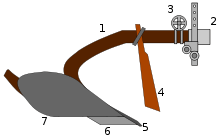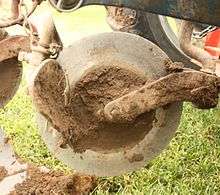Coulter (agriculture)

A coulter or colter is a vertically mounted component of many plows that cuts an edge about 7 inches (18 cm) deep ahead of a plowshare.[1] Its most effective depth is determined by soil conditions.[2]
History
Its earliest design consisted of a knife-like blade.[3][1] Coulters with a flat rotating disc began being used c. 1900.[4][1] Its advantage was a smoothly cut bank, and it sliced plant debris to the width of the furrow.[2]
Results
In his 1844 book, Henry Stephens used dynamometer measurements to conclude that a plow without a coulter took about the same amount of force to pull but using a coulter resulted in a much cleaner result.[1] It softens the soil, allowing the plow to undercut the furrow made by the coulter.[1]
Jointer

A rolling coulter has an optional accessory called a "jointer".[2] The jointer flips over a small part of the surface on top of the slice before the plowshare flips the main slice.[2] It ensures that all of the plant debris gets covered by the flipped slice.[2]
References
- 1 2 3 4 5 Stephens, Henry (1854). The Book of the Farm. W. Blackwood. pp. 271–272.
- 1 2 3 4 5 Bacon, Charles Allen (1920). The Oliver plow book: a treatise on plows and plowing. Oliver Farm Equipment Company. pp. 160–162.
- ↑ "Our Steel Beam Rod Breakers from $6.50 to $7.70". 1896 Sears Roebuck & Co. catalog. Missing or empty
|url=(help);|access-date=requires|url=(help) - ↑ "Our $9.75 Walking Plow". 1896 Sears Roebuck & Co. Catalog. Missing or empty
|url=(help);|access-date=requires|url=(help)